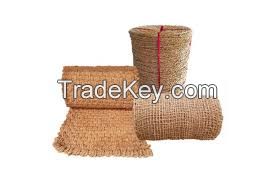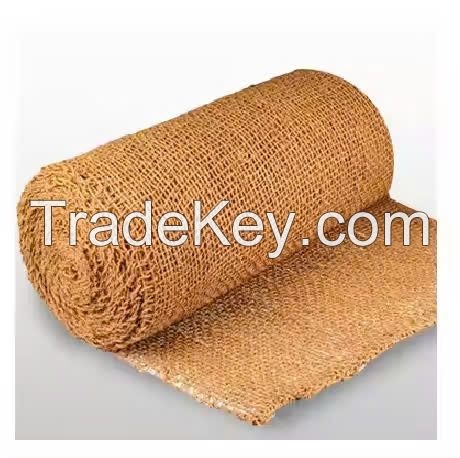





FOB Price
Get Latest Price6.5 ~ 8.5 USD / Roll ( Negotiable )
|1000 Roll Minimum Order
Country:
Vietnam
Model No:
Tracy cocofibernet- H1288
FOB Price:
6.5 ~ 8.5 USD / Roll ( Negotiable ) Get Latest Price
Place of Origin:
Vietnam
Price for Minimum Order:
6.5 per Roll
Minimum Order Quantity:
1000 Roll
Packaging Detail:
customer's request
Delivery Time:
10 to 15 days
Supplying Ability:
10000 Roll per Day
Payment Type:
T/T, L/C, Western Union
Product Group :
Coconut fiber, or coir, is a natural material extracted from the husk of coconuts. It is widely known for its durability, water retention properties, and eco-friendliness. One of the most versatile applications of coconut fiber is in the production of coconut fiber nets, also called coir nets. These nets are used in various industries, including agriculture, landscaping, erosion control, and horticulture, due to their ability to promote plant growth, prevent soil erosion, and offer an environmentally sustainable alternative to synthetic materials.
Coconut fiber nets are made by weaving coir fibers into a mesh structure, creating a grid-like pattern that is flexible yet strong. These nets are biodegradable, durable, and have excellent water retention properties, making them a preferred choice for applications where soil stabilization, plant growth, and environmental conservation are key concerns.
Composition and StructureThe primary material used in the construction of coconut fiber nets is coir, which is extracted from the outer husk of mature coconuts. The coir fibers are long, thick, and highly resistant to saltwater and microorganisms, making them ideal for both coastal and inland applications.
A typical coconut fiber net consists of tightly woven coir fibers, which are arranged in a grid or mesh-like pattern. The size of the grid can vary depending on the intended application, with some nets featuring large, open spaces between the fibers, and others having a denser, tighter weave. The thickness and density of the net are determined by the amount of fiber used and the weaving technique employed.
Coconut fiber nets are available in different grades and types, depending on the level of durability, water retention, and strength required. Some nets are reinforced with additional materials, such as jute or natural ropes, to enhance their strength and longevity, especially for applications where greater durability is necessary.
Production Process
Harvesting and Fiber Extraction:
The production of coconut fiber nets begins with the
harvesting of mature coconuts. Once the coconuts are
harvested, the husks are separated from the fruit. These
husks contain both long and short fibers, which are soaked in
water to soften them. After soaking, the fibers are
extracted, cleaned, and dried.
Fiber Preparation and Spinning:
The coir fibers are then spun into yarn, which forms the
basic material for creating the coconut fiber nets. The
spinning process ensures that the fibers are aligned
properly, providing the necessary strength and durability to
the net. In some cases, additional treatments such as boiling
or chemical processing are applied to the fibers to enhance
their resistance to pests and decay.
Weaving the Nets:
Once the coir yarn is prepared, it is woven into a net using
either manual or mechanical looms. The weaving process
involves intertwining the fibers into a grid pattern, with
the size of the grid varying according to the specific
application. Handwoven nets are typically used for artisanal
or specialized applications, while machine-made nets are
preferred for large-scale industrial use.
Finishing and Quality Control:
After weaving, the coconut fiber nets undergo a finishing
process, where they are checked for quality, uniformity, and
strength. Any irregularities are corrected, and the nets are
treated to ensure that they are free from impurities and
moisture. The finished product is then packaged and stored
for distribution.
Coconut fiber nets are highly versatile and find applications in various sectors, including:
Soil Erosion Control:
One of the most common uses of coconut fiber nets is in
controlling soil erosion, particularly on slopes, riverbanks,
and coastal areas. The nets are laid over the surface of the
soil, where they act as a protective layer that stabilizes
the soil and prevents it from being washed away by rain,
wind, or water currents. Over time, the coir net biodegrades,
allowing vegetation to grow through the mesh and further
stabilize the soil.
Landscaping and Green Infrastructure:
In landscaping and urban development projects, coconut fiber
nets are used to create green infrastructure solutions, such
as living walls, green roofs, and vertical gardens. The coir
fibers help retain moisture and provide a natural growing
medium for plants, making them ideal for use in areas where
natural vegetation is encouraged.
Agriculture and Horticulture:
In agriculture, coconut fiber nets are used as a ground cover
to suppress weeds, retain soil moisture, and promote healthy
plant growth. They provide a biodegradable alternative to
synthetic weed control fabrics and plastic mulch. In
horticulture, they are used as a substrate for hydroponic
growing systems, where their water retention and air
permeability properties are beneficial for plant root
systems.
Construction and Civil Engineering:
Coconut fiber nets are often used in construction and civil
engineering projects to provide temporary support for soil
and plants. For example, they are employed in the
construction of embankments, where they offer short-term
protection while the vegetation establishes itself and
stabilizes the structure. In road construction, coconut fiber
nets help protect freshly graded slopes from erosion until
permanent vegetation takes hold.
Coastal and Wetland Restoration:
In coastal areas and wetlands, coconut fiber nets are used to
protect shorelines and prevent the loss of valuable wetland
ecosystems. The nets are laid along the shoreline to
stabilize the soil and promote the growth of salt-tolerant
plants, which further help to anchor the soil in place. This
technique is particularly useful in areas prone to coastal
erosion and rising sea levels.
Wildlife Habitats and Conservation
Projects:
In wildlife habitats and conservation projects, coconut fiber
nets are used to create natural environments that support
plant and animal life. The biodegradable nature of coir
ensures that the nets do not harm wildlife, and as they
decompose, they contribute organic material to the soil,
enriching it and promoting biodiversity.
Eco-Friendly and Sustainable:
Coconut fiber nets are an environmentally friendly
alternative to synthetic materials. Coir is a renewable
resource, as coconuts are harvested multiple times per year,
and the production process has a low environmental impact.
Furthermore, the nets are fully biodegradable, decomposing
naturally over time and leaving no harmful residues in the
soil.
Water Retention and Air Permeability:
Coir fibers have excellent water retention properties, which
makes coconut fiber nets highly effective in retaining
moisture and preventing soil dehydration. This is
particularly useful in areas with dry climates or where water
conservation is a priority. At the same time, the nets porous
structure allows air to circulate freely, promoting healthy
root growth for plants.
Durability and Strength:
Despite being a natural material, coconut fiber is remarkably
strong and durable. Coir fibers are resistant to rot,
saltwater, and microorganisms, making them suitable for
long-term outdoor use in a variety of environmental
conditions, from arid regions to coastal areas.
Biodegradability:
One of the most significant benefits of coconut fiber nets is
their biodegradability. Over time, the nets break down
naturally, enriching the soil with organic material. This
eliminates the need for removal and disposal, which is often
required with synthetic erosion control products.
Cost-Effective:
Coconut fiber nets offer a cost-effective solution for
erosion control, landscaping, and agricultural applications.
Their long lifespan and low maintenance requirements make
them a budget-friendly option, particularly when compared to
synthetic alternatives that may require frequent replacement
or removal.
Encourages Vegetation Growth:
The grid-like structure of coconut fiber nets allows plants
to grow through the mesh, creating a natural and stable
environment for vegetation. This is particularly useful in
erosion control projects, where the growth of vegetation
helps to anchor the soil and prevent further erosion.
The use of coconut fiber nets aligns with the growing global trend toward sustainability and environmental conservation. The production of coir does not harm the environment, as it is a byproduct of the coconut industry, which itself is a sustainable agricultural practice. The fibers are extracted using traditional methods that require minimal energy and no harmful chemicals.
Moreover, coconut fiber nets help reduce the environmental impact of erosion control and landscaping projects by providing a natural, biodegradable solution that does not contribute to plastic pollution. As they decompose, the coir fibers enrich the soil with organic matter, improving soil quality and promoting plant growth.
ConclusionCoconut fiber nets are a sustainable, eco-friendly, and highly versatile product that offers numerous benefits for a wide range of industries. From soil erosion control and landscaping to agriculture and coastal restoration, these nets provide an effective and environmentally responsible solution. Their durability, water retention capabilities, and biodegradability make them a superior alternative to synthetic materials, aligning with modern trends toward sustainable and green infrastructure solutions. As the world continues to prioritize environmental conservation, the demand for products like coconut fiber nets is likely to grow, cementing their place as a key tool in sustainable development projects.
| Country: | Vietnam |
| Model No: | Tracy cocofibernet- H1288 |
| FOB Price: | 6.5 ~ 8.5 / Roll ( Negotiable ) Get Latest Price |
| Place of Origin: | Vietnam |
| Price for Minimum Order: | 6.5 per Roll |
| Minimum Order Quantity: | 1000 Roll |
| Packaging Detail: | customer's request |
| Delivery Time: | 10 to 15 days |
| Supplying Ability: | 10000 Roll per Day |
| Payment Type: | T/T, L/C, Western Union |
| Product Group : | agriculture |




